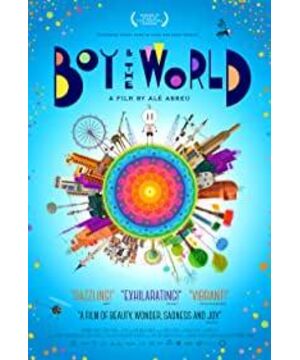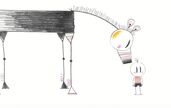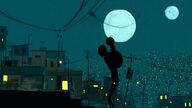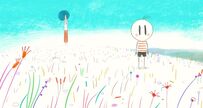Dad left home to work, and the boy's original world collapsed. He kept seeing the figure of his imaginary father and what they had done in his hometown. There is a foreshadowing: Dad loves to play the flute, and he always plays the title stone. The familiar monotonous melody, the boy put the notes in the air together with his mother's singing into a small jar and buried it in the ground; his father and mother also planted a tree together.
Without a father, the child trapped in the countryside is doomed to be rebellious. He finally left home on a rainy night, and he imitated the train carrying a box with an exaggerated size and weight and a family photo... The director did not explain who this child was. How did I meet the old farmer in the cotton field? It just suddenly changed the style of painting, and used a series of fast-changing black background line drawings to show the nightmarish bumps along the way. When I woke up, the boy joined the old man and other farmers to pick cotton neatly. Look at this part of the picture. It seems to be beautiful and harmonious, and it seems to show an ideal working environment, but the atmosphere is quickly swept away by the ominous atmosphere brought by giant trucks and planes.
The pyramid-like urban design also symbolizes that the most developed and densely populated cities in Brazil are located in the southeastern part of the Atlantic coast, where there are Sao Paulo and Rio, and the south is also the plateau area. The environment has deteriorated to the end, and every stranger has become a father. The boy who has no hope of finding his father has to look back on his heavenly childhood memories. At this point, the director began to unveil it quietly: the old man, the young man, and the child are actually the same person. What the film tells is the fable about the development of Brazil, the fable of the globalized economy, the fable of the agricultural culture being destroyed by the industrial culture, and the common story of the whole life of working people all over the world. It’s the magical reality of One Hundred Years of Solitude, and it’s a Proustian moment of parallel time.
The story has long been foreshadowed: the clothes of children, old people, and young people are the same color; the trees planted by parents grow into small saplings when the boy is young, and he becomes the big red tree in his old age; young workers who have just lost their jobs wear their mother's knitted saplings. The colorful hat, reading the cotton field recruitment poster... It is interesting that no matter what age group, no matter in the cotton field or the cloth factory, the boy has never lost his innocence. The beauty represented by playing music is the boy's confrontation. The weapon of the world's malice is also the magic weapon for him to live peacefully with the world. The musical notes are colored, the artist's brocade clothes put on by the youth are also colored, and the happy bird that rises from people's singing is also colored. , The black giant bird that the convergent culture has turned into fights, even if it falls, it can still be resurrected like Lazarus.
The director's childlike imagination has turned into many elegant scenes, such as a rainy day turning into waves on the river, such as a boy looking at the kaleidoscope in his hand wholeheartedly, inadvertently stepping onto a big boat from a piece of "springboard", crossing the ocean, stringing cloth The whole process of ready-to-wear. The story is not over yet, the lonely old man put on the colorful hat of his youth, put on the colorful clothes of his youth, and finally returned to the colorful stone at the beginning of the film. It turned out that it was the can he buried. When he opened it, he was still there. Can hear the familiar notes that I treasure: Dad's flute, Mom's singing. He can go back to his parents' arms again, rejuvenating his youth.
View more about The Boy and the World reviews







